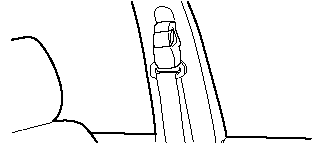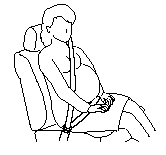Seat Belt Precautions
Seat belts help to decrease the possibility of severe injury during accidents
and sudden
stops. Mazda recommends that the driver and all passengers always wear seat
belts.
All of the seat belt retractors are designed to keep the lap/shoulder belts out
of the way
when not in use.
The driver's seat belt has no provisions for child-restraint systems and has
only an
emergency locking mode. The driver may wear it comfortably, and it will lock
during a
collision.
However, the front passenger's seat and all rear lap/shoulder belt retractors
operate in two
modes: emergency locking mode, and for child-restraint systems, automatic
locking mode.
While we recommend you put all children in the rear seats, if you must use the
front
passenger seat for a child, slide the front passenger seat as far back as
possible and make
sure any child-restraint system is secured properly.
WARNING:
Always wear your seat belt and make sure all occupants are properly restrained:
Not wearing a seat belt is extremely dangerous. During a collision, occupants
not
wearing seat belts could hit someone or things inside the vehicle or even be
thrown
out of the vehicle. They could be seriously injured or even killed. In the same
collision, occupants wearing seat belts would be much safer.
Do not wear twisted seat belts:
Twisted seat belts are dangerous. In a collision, the full width of the belt is
not
available to absorb the impact. This puts more force on the bones beneath the
belt,
which could cause serious injury or death.
Never use one seat belt on more than one person at a time:
Using one seat belt for more than one person at a time is dangerous. A seat belt
used in this way cannot spread the impact forces properly and the two passengers
could be crushed together and seriously injured or even killed. Never use one
belt for
more than one person at a time and always operate the vehicle with each occupant
properly restrained.
Do not operate a vehicle with a damaged seat belt: Using a damaged seat belt is dangerous. An accident could damage the belt webbing of the seat belt in use. A damaged seat belt cannot provide adequate protection in a collision. Have an Authorized Mazda Dealer inspect all seat belt systems in use during an accident before they are used again.
Have your seat belts changed immediately if the pretensioner or load limiter has
been expended:
One or both front air bags may deploy, and the corresponding pretensioner(s) may
also deploy at the same time. Like the air bags, the seat belt pretensioners
will only
function once. While it is safer to use a post-crash (a seat belt that was used
in an
accident) than no seat belt at all, using a seat belt with an expended
pretensioner or
load limiter loaded reduces the safety available to you. If the seat belt
pretensioners
are not replaced, the risk of injury in a collision will increase. Expended seat
belt
pretensioners and air bags must be replaced after any collision which caused
them
to deploy. Additionally, the load limiter will only limit loads on the chest
once in a
collision and this is another reason to have the front seat belts inspected.
Always
have an Authorized Mazda Dealer inspect the seat belt pretensioners and air bags
after any collision.
CAUTION:
Belt retraction may become difficult if the belts and rings are soiled, so try
to keep
them clean. For more details about cleaning the seat belts, refer to “Cleaning
the
Lap/Shoulder Belt Webbing”.

PregnantWomen and Persons with Serious Medical Conditions
Pregnant women should always wear seat belts. Ask your doctor for specific recommendations.
The lap belt should be worn SNUGLYAND AS LOWAS POSSIBLE OVER THE HIPS.
The shoulder belt should be worn across your shoulder properly, but never across
the
stomach area.
Persons with serious medical conditions also should wear seat belts. Check with
your
doctor for any special instructions regarding specific medical conditions.

Emergency Locking Mode
In the emergency locking mode, the belt remains comfortable on the occupant
and the
retractor will lock in position during a collision. When the seat belt is
fastened, it will
always be in the emergency locking mode until it is switched to automatic
locking mode by
pulling it all the way out to its full length. If the belt feels tight and
hinders comfortable
movement while the vehicle is stopped or in motion, it may be in the automatic
locking
mode because the belt has been pulled too far out. To return the belt to the
more
comfortable emergency locking mode, wait until the vehicle has stopped in a
safe, level
area, retract the belt fully to convert it back to emergency locking mode and
then extend it
around you again.
If the belt is locked and cannot be pulled out, retract the belt once, and then
try pulling it
out slowly. If this fails, pull the belt strongly one time and loosen, then pull
it out again
slowly.
Automatic Locking Mode
Always use the automatic locking mode to keep the child-restraint system from
shifting to
an unsafe position in the event of an accident. To enable seat belt automatic
locking mode,
pull it all the way out and connect it as instructed on the child-restraint
system. It will
retract down to the child-restraint system and stay locked on it. See the
section on child
restraint.
See also:
Uniform Tire Quality Grading System (UTQGS)
This information relates to the tire grading system developed by the U.S.
National
Highway Traffic Safety Administration for grading tires by tread wear, traction,
and
temperature performance.
...
Exterior & Styling
Technically the same generation as the 2008, the 2009 model's restyling is
definitely noticeable, as the nose extends lower and the grille is now larger
and smile-shaped. Unlike the Mazda3, this s ...
Steps for Determining the Correct Load Limit:
Steps for Determining Correct Load Limit:
(1) Locate the statement “The combined weight of occupants and cargo should
never exceed XXX kg or XXX lbs” on your vehicle's placard.
(2) Determine the co ...


